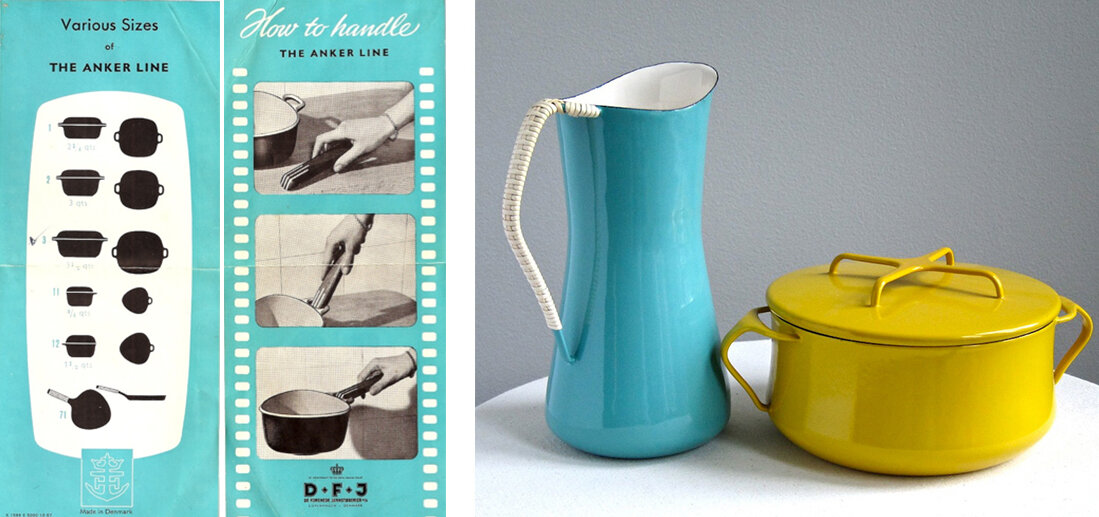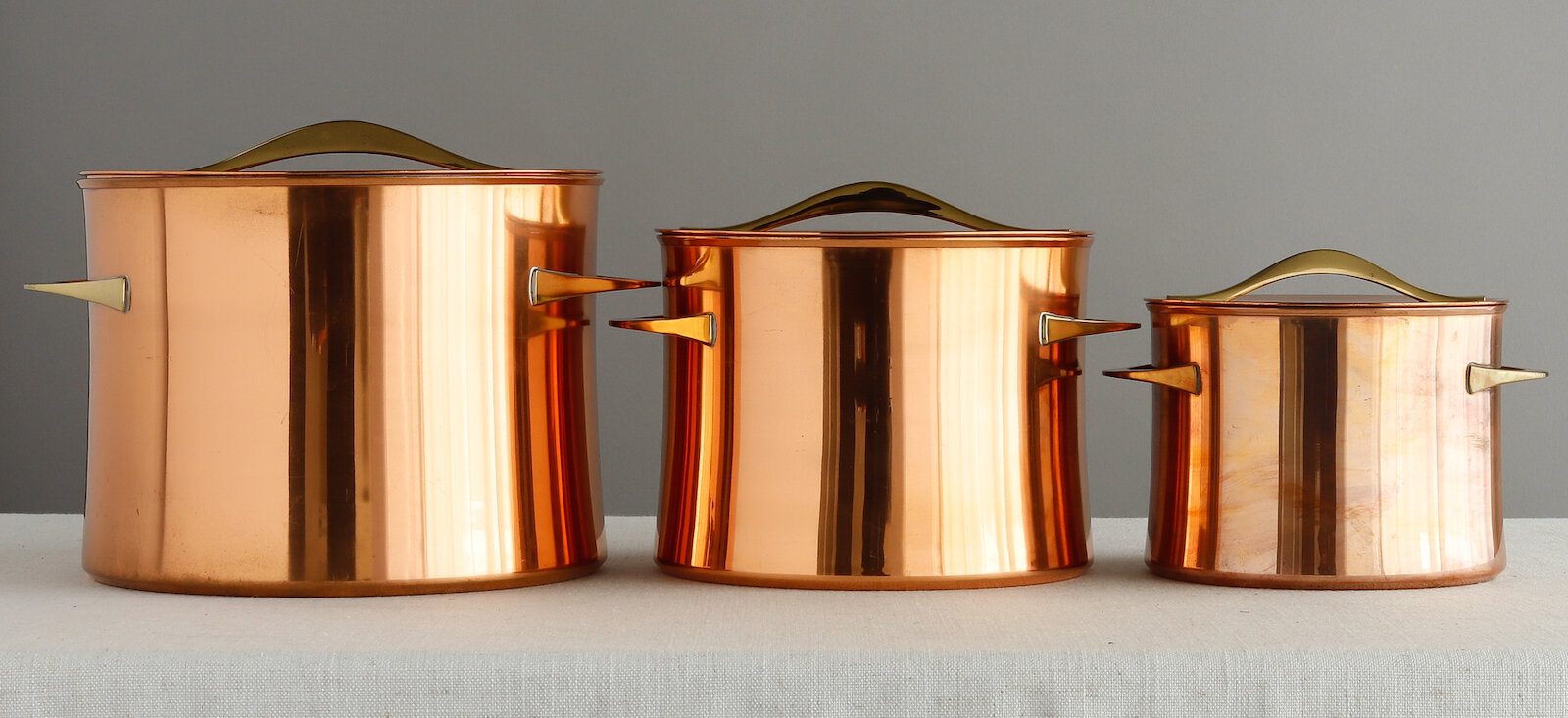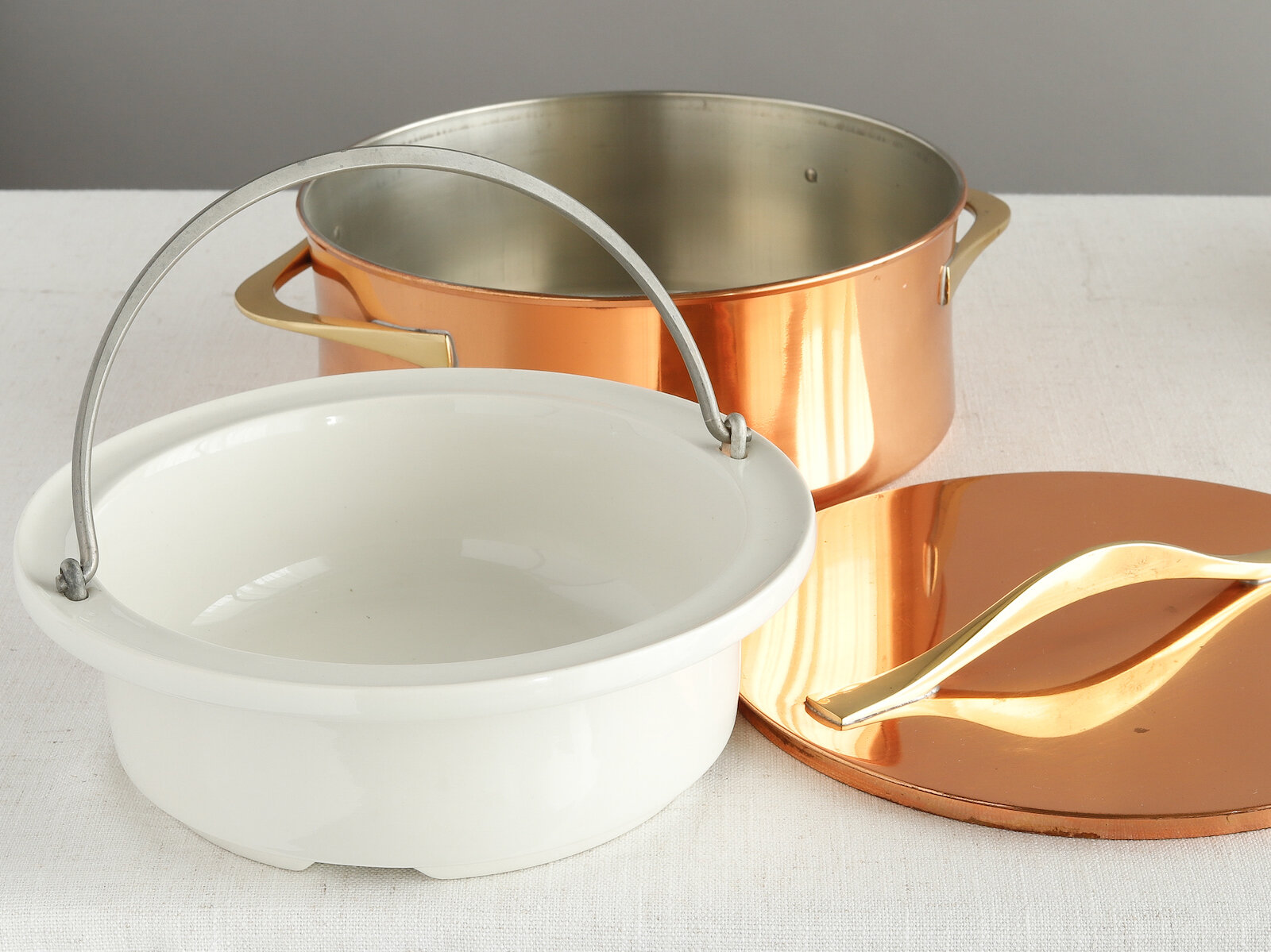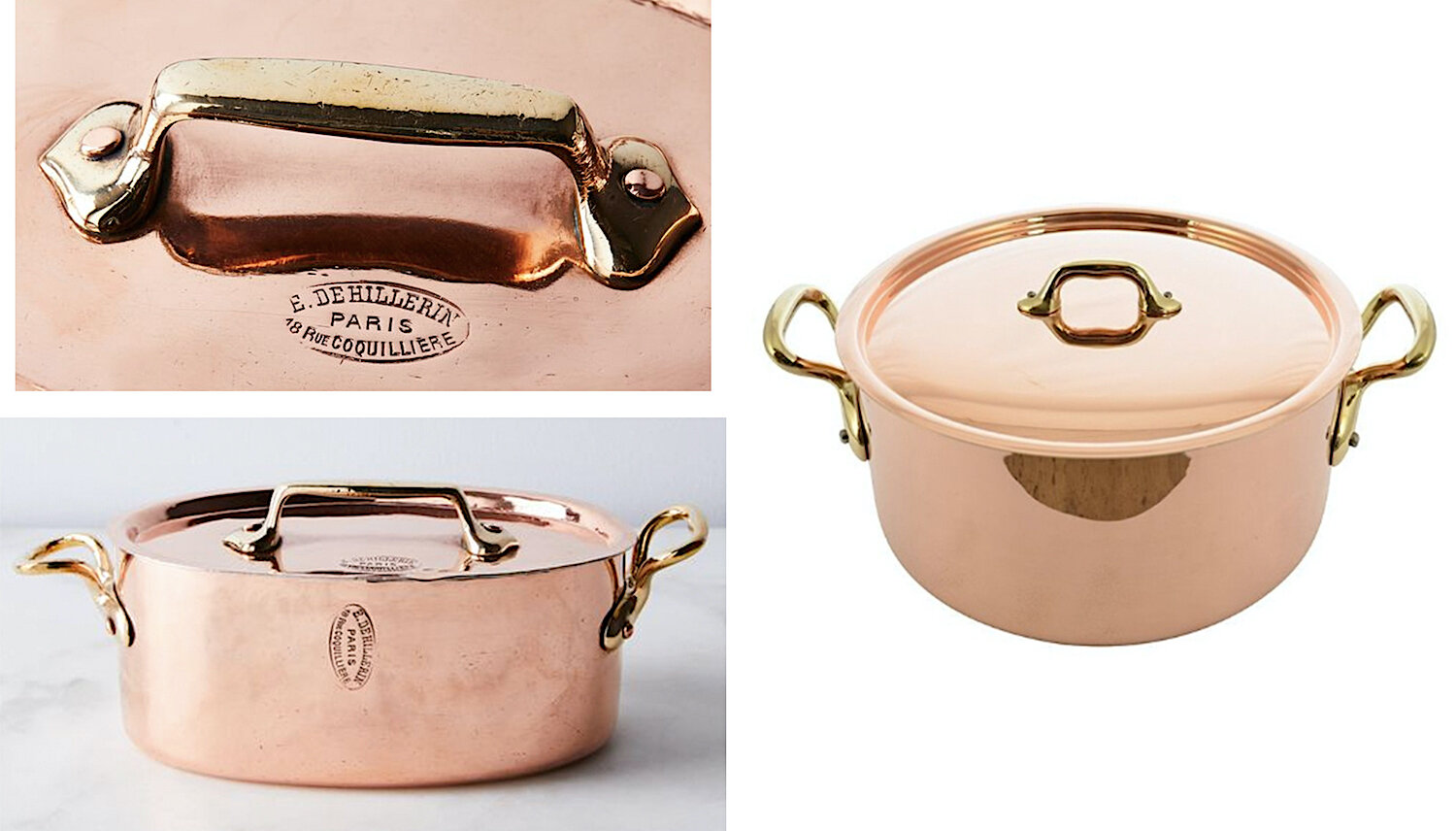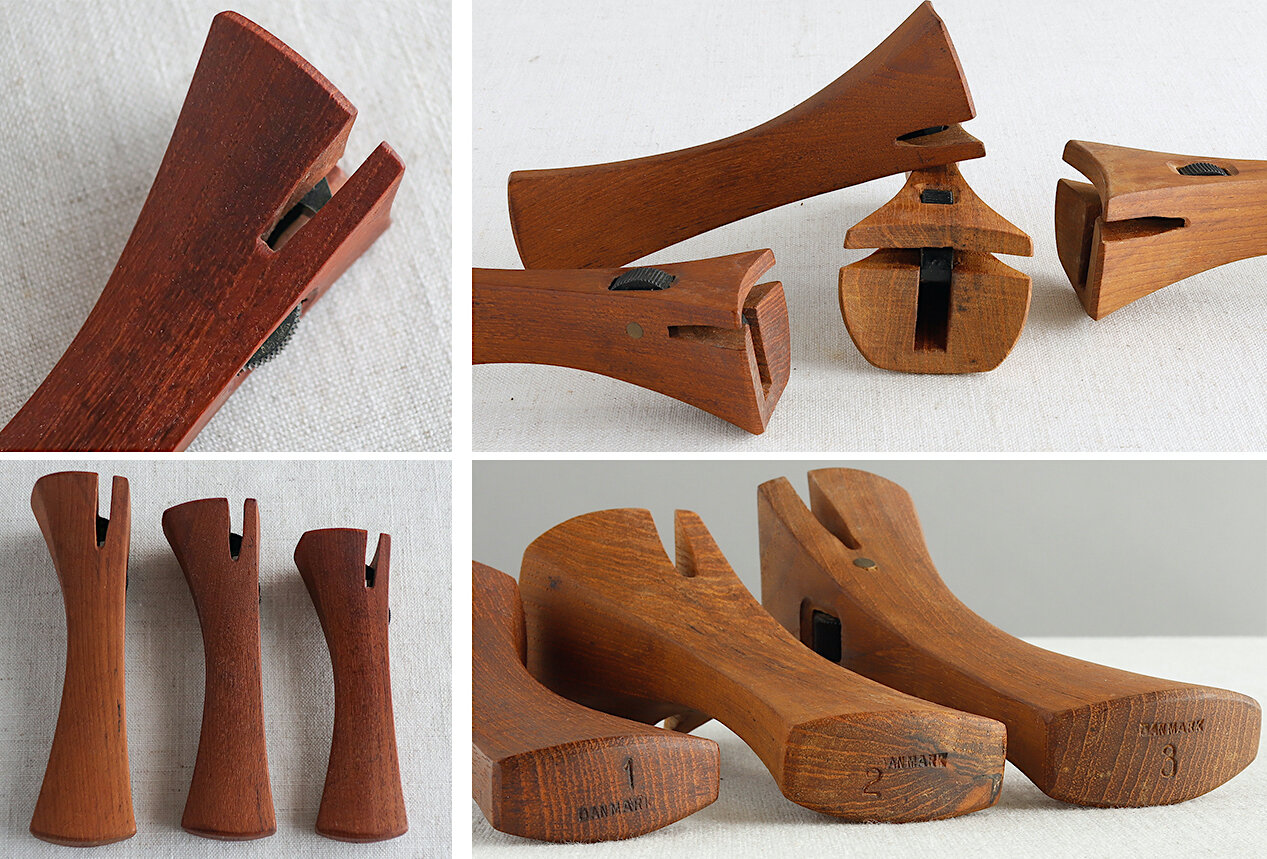I recently acquired the entire line of copper cookware designed by Jens Quistgaard for Dansk. It appears never to have been used.
Pots and pans were an early design concern of Quistgaard. Though he had been designing objects in the 1940s, by the mid 1950s Quistgaard found success with his creation the Anker Line of enameled cast-iron cookware produced by De Forenede Jernstoberier. Shortly after joining Dansk, Quistgaard designed his Kobenstyle cookware, a much more lightweight metal enameled in primary colors.
Pages from a pamphlet for Anker Line (which also featured removable handles), and examples of Kobenstyle, both designed by Quistgaard.
In the productive years around 1960, when Dansk released numerous new lines including Rare Woods, Festivaal, Cane and Teak, and several new flatware patterns, Quistgaard developed the line of cookware that would bear his name: Quistgaard’s Copper.
Page from an undated Dansk catagloue, circa 1960.
7-, 4-, and 2-quart copper casseroles.
All three of the taller casseroles came with porcelain liners.
3.5-, 2-, and 1-quart copper saucepans
Only the largest of the saucepans (3.5-quart) has a porcelain liner.
Traditional copper pots. The pot on the left is by Dehillerin of Paris, the firm favored by Julia Child. Via Food 52.
Copper pots for cooking and other household uses have been made for millennia. Copper heats quickly, disperses heat evenly, and cools off quickly, all of which makes for good control when cooking. Ingesting copper is not good, so most pots are lined with another material. Dansk copper is lined with tin, often used because it will not react with acids and is fairly non-stick; tin, though is soft and has a low melting point, so it is prone to wear if not handled properly.
The rivets are polished flush with the handles.
Quistgaard’s copper came in taller casseroles and shorter saucepans. The pots, made in Portugal, were copper lined with tin, with brass handles. He kept the main elements of traditional copper pots and simplified the lines of the handles and eliminated the obvious connectors. The pots were touted as ‘casserole, kettle, double boiler, wine cooler, chafing dish, one at a time or all in one.’ Lids, porcelain liners, and teak handles were all sold separately.
Three sizes of removable teak handles, made in Denmark. The wheel at the top of the handle releases the internal hook. The wheel can be very difficult to turn.
From an undated Dansk price list, circa 1960.
Quistgaard’s copper was expensive as compared to other pieces produced for Dansk. The largest copper pot (7 quarts) with the lid, porcelain liner, and wood handle cost $52.85, whereas the largest Kobenstyle piece, the 6-quart casserole, was only $16.95. A five-piece place setting of the sterling silver Tjorn flatware was $49.95, the same price at which the largest pieces from the Rare Woods line topped out. The chafing dish (which was apparently never illustrated in catalogues) was the most expensive single item in the line, at $69.80.
Brass and teak chafing dish, model 1310CH. This piece was shown in Dansk advertisements as early as 1956, before the copper line was introduced. Photo via Invaluable.
Brass burner and stand. The teak on the underside of the stand has the usual Dansk mark for this period and the brass cross piece is also marked.
Dansk advertisement with Bert Stern photo featuring the 7-quart casserole on the burner and stand, 1960.
The copper line was featured in Dansk advertisements in 1960 and 1961, the former of which was photographed by fashion photographer Bert Stern. Stern, known for many iconic images from the 1960s including the the last photo shoot of Marilyn Monroe before her death, shot for Dansk from 1957 until at least 1960.
Manufacturer’s care card, which notes the need to remove the lacquered finish on the pots before use.
Mimeographed (or ditto?) memo from Dansk about caring for the pots.
Whether due to low demand or high production costs, Quistgaard’s copper only seems to have been made for a very short time in the early 1960s. The less expensive Kobenstyle line, however, continued for many years (and was recently reproduced), and Quistgaard went on to design another line of enameled cast-iron cookware around 1970.
The underside of some—but not all—brass handles were marked with the Dansk four ducks mark; some also had a foil label on the underside of the pot.
This lid is from a different set of pots and shows that the inner rim of some lids were stamped with the Dansk mark.
The Dansk mark was also included on the underside of the porcelain liners (though I have seen liners that are unmarked).
I have found additional unused copper pots in this pattern that were not marked on the handles (but had the Dansk label on the underside), and confusingly, included both the ‘Hand Crafted Copper’ insert seen above and a care card insert that gave the company name as Dansk Designs International, which was used in the 1970s. During that decade (or maybe the 1980s?), Dansk did produce another line of copper pots that were made in Norway. I can’t imagine the two designs were sold at the same time? Definitely an area for more research…


